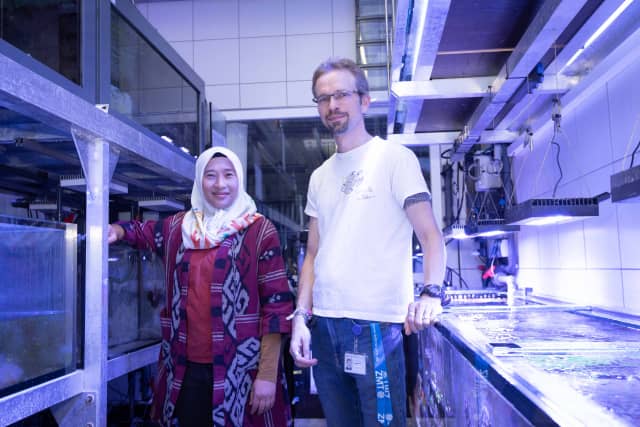26/07/2022 | ZMT scientist Estradivari from Indonesia is one of the authors of the recently issued publication “The good, the bad, and the ugly: reflections on co-designing science for impact between the Global South and Global North”. It is the first paper published in the ICES Journal of Marine Science's "Stories from the Front Lines" series on the co-design of ocean science for sustainable development, a joint effort between the journal, the Ocean KAN (Knowledge-Action Network), SmartNet, and the UN Decade of Ocean Science for Sustainable Development.
What was the initial question of the study?
Estradivari: We, four researchers with extensive experience in international science collaborations to support marine conservation (two from the Global South and two from the Global North), explore the benefits and challenges of implementing co-designed science. Reflections and examples - the good, the bad, and the ugly - are given on how we implement co-designed science and how it can succeed or fail. Co-designed science refers to the collaborative conceptualization and execution of research by various scientific and non-scientific partners. Besides these, we also share good practices and habits that have assisted us in improving our collaboration.
What exactly did you investigate?
Estradivari: We provide first-hand experiences and reflections with a focus on five thematic areas: funding and associated power dynamics, differences in research culture and training, diverse interests and needs, authorship norms, and the balance of inclusion.
What are the new findings?
Estradivari: Our experiences show that co-designed science can have a greater and more meaningful "real-world" impact. We documented numerous benefits and examples of how it can result in policy and practice changes. On the other hand, we learned and demonstrated that implementing co-designed science can be difficult and time-consuming, and even with good intentions, things can go wrong. Regardless, we believe co-designed science should be promoted and implemented in order to advance much more collaborative, inclusive, and impactful research. We must improve our mindsets, practices, and systems to promote an effective co-designed science process.
Can you give examples for successful co-designing of research…
Estradivari: One of the key successes of co-designed science is to align diverse interests and needs among researchers, policymakers, and practitioners. In one case, we provide an example of designing marine conservation that benefits fisheries in Indonesia. This topic was a high priority for the in-country government and researchers, yet little existing research has been done to support implementation. This research gap aligned with the interests of Global North researchers, who worked alongside Global South researchers within NGOs to do well-funded and applied science as a basis for in-country conservation design. This resulted in a number of scientific and non-scientific products with "real-world impact".
Co-designed science can also be successful if diverse research cultures and training are aligned. The Western Indian Ocean Marine Science Association (WIOMSA), for example, fosters a culture of co-designed research and capacity development. Researchers from the Global South frequently bring research experience grounded in local needs, cultures, and customs, whereas researchers from the Global North often bring access to formal Western scientific training and tools that help guide impactful research.
…and examples for unsuccessful co-designing?
Estradivari: While we have seen and demonstrated some successful co-designed science, we also have experienced that co-designed science can go wrong or fail, resulting in conflicts, unethical behaviour, distrust, and low-quality science. For example, we have been in situations where Global North researchers used Global South researchers to get research permits to conduct fieldwork and then used the data they collected in Global South countries for publications without involving in-country researchers.
We also have experienced how donors drive their research interests without aligning with the in-country needs, creating an imbalance in power dynamics. In another case, we have seen that the relationship between collaborators was damaged because the research fell short of expectations. Co-designed science requires a lot of negotiation and discussion, which can be time- and resource-consuming.
What conclusions can be drawn from your findings? What will make co-designing work?
Estradivari: Our main message is that co-designed science is critical for a real change in policy and practice. We encourage researchers to promote and implement co-designed science whenever possible. However, it is important to note that implementing it can be difficult, time-consuming, and resource-intensive. Therefore, it is critical to understand the key aspects that can support successful co-designed science, when to refrain from co-designed science if the situation is unfavorable, and whether it is a good fit for the research.
For better and more effective co-designed science, we must improve our mindsets, practices, and systems, especially in these three key areas: (1) prioritizing flexible funding opportunities to enable a well-facilitated co-design process, (2) being intentional about who we co-design with and how we co-design to ensure that we spend our limited time in meaningful co-design, and (3) promoting research needs as a more inclusive process that is not only reserved for those with specific skills or training.
Why are the results relevant for science?
Estradivari: We need collaborative actions to solve complex environmental and societal problems in this rapidly changing world, making the world a better place to live. The UN Decade of Ocean Science for Sustainable Development is consistently promoting co-designed science as one of the strategies to support transformative ocean actions. While there is widespread enthusiasm for participation in this collaborative venture, many people may be unfamiliar with co-designed science, and those who have implemented it may not share their successes, failures, and lessons learned with others. Our first-hand experiences and reflections can be useful to improve co-designed science processes and provide guidance for those who want to implement it.
Publication
Mahajan, SL, Estradivari, Ojwang L, Ahmadia GN. 2022. The good, the bad, and the ugly: reflections on co-designing science for impact between the Global South and Global North. ICES Journal of Marine Science, 0: 1-4. DOI: 10.1093/icesjms/fsac115





